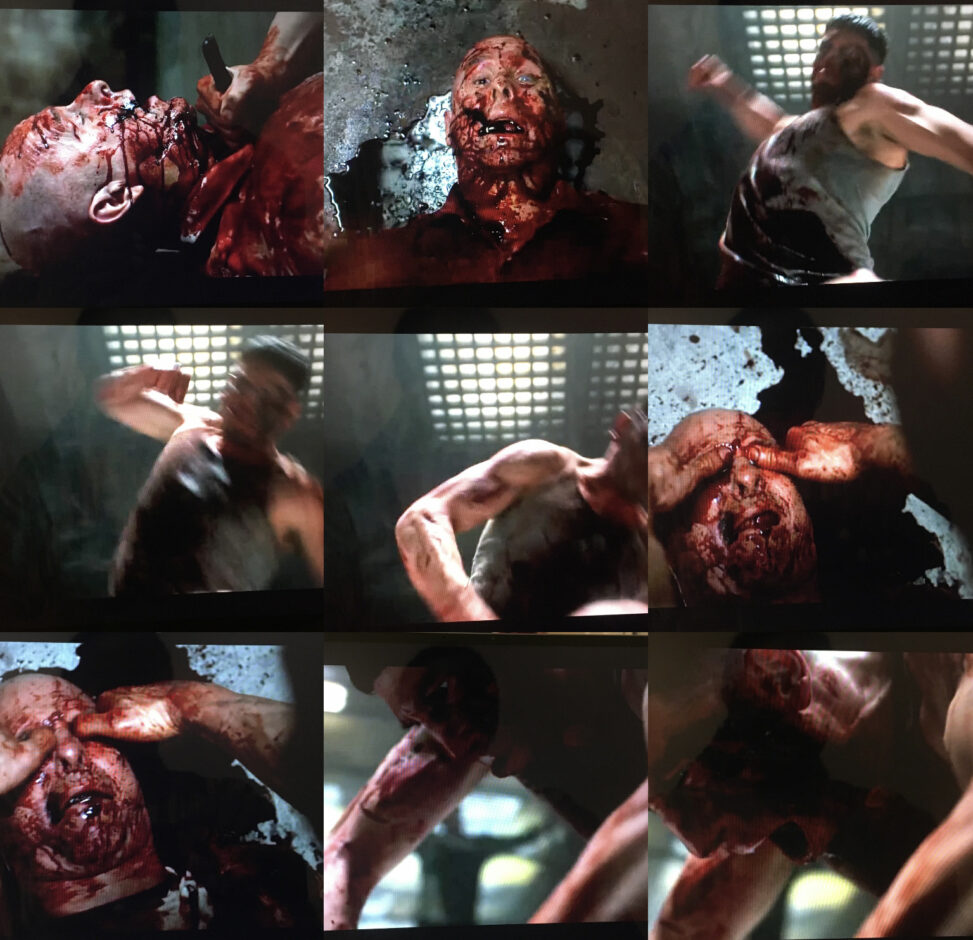The Punisher, a Marvel series on Netflix, is known for its raw depiction of vigilante justice. The show follows Frank Castle, a former Marine who becomes a violent anti-hero after the murder of his family. In Season 1, Episode 12, Castle kills Agent Orange (William Rawlins), a corrupt government official. This pivotal moment in the series is both a culmination of Castle’s vendetta and a brutal portrayal of vengeance. The scene’s visual intensity and emotional weight make it a prime subject for analyzing the use of violence in contemporary action media.
Screen Grab and Mise en Scene Analysis The chosen images illustrate the extreme physicality and emotional anguish present in the scene. The mise en scene is marked by a dark, grimy environment, suggestive of imprisonment and moral decay. The confined, dimly lit room contrasts with the bright, harsh lighting that emphasizes the blood-streaked faces and the visceral nature of the violence. Castle’s bloodied tank top, indicative of physical struggle, mirrors the psychological toll of his quest for justice.
The use of practical effects, including fake blood and makeup, adds realism. The metallic, industrial backdrop reinforces a sense of lawlessness and retribution. The color palette, dominated by red, black, and gray, evokes an atmosphere of brutality. This grim aesthetic is characteristic of the neo-noir genre, further intensifying the narrative’s tone.
Editing and Cinematic Techniques The scene employs rapid, chaotic editing to heighten the tension. Within a single minute, multiple quick cuts occur, capturing every blow and facial reaction. The camera shifts between close-ups of Castle’s grim determination and wide shots emphasizing Rawlins’ helplessness. The handheld camera work creates a sense of immediacy and disorientation, immersing the viewer in the confrontation.
Additionally, the scene employs slow-motion shots to accentuate particularly violent moments. This deliberate pacing forces viewers to confront the brutality rather than passively observe it. The editing also manipulates the audience’s emotional response by extending moments of pain and anguish, evoking empathy or discomfort.
Representation of Gender, Race, and Ability The scene prominently features Frank Castle, a hyper-masculine white male, wielding violence as a means of justice. This characterization reinforces traditional action-hero tropes. Agent Orange, also a white male, symbolizes institutional corruption. The absence of female characters in this moment further underscores the masculine dominance within the action genre.
Moreover, the scene reflects themes of moral ambiguity and trauma. Castle’s use of violence is portrayed as both justified and unsettling, complicating the audience’s perception of heroism. While the show critiques corrupt systems, it simultaneously glorifies vigilante justice, contributing to a larger discourse on the normalization of violence in media.
Critical Analysis Scholarly research suggests that exposure to violent media can desensitize viewers and reinforce aggressive behavior.1 In particular, the glorification of vigilante violence in The Punisher may contribute to the perception that extrajudicial actions are justified in real life.2 Furthermore, representations of hyper-masculinity in action films often correlate with reinforced gender stereotypes and toxic masculinity.3
However, some scholars argue that media violence can provide catharsis and facilitate discussions on moral and ethical dilemmas.4 In this context, The Punisher invites viewers to reflect on the consequences of vengeance and the cyclical nature of violence.
Box Office Performance While The Punisher is a streaming series rather than a theatrical release, its success can be measured through viewership statistics and critical reception. According to data from Nielsen, the series consistently ranked among the most-watched Netflix originals, garnering significant attention upon its release. Its popularity led to a second season, further solidifying its cultural impact.
Real-Life Consequences The portrayal of violence in The Punisher raises concerns about media influence. Studies have shown that repeated exposure to violent content can contribute to increased aggression and reduced sensitivity to real-world violence.5 Additionally, the glorification of vigilante figures may distort perceptions of justice and encourage a belief in personal retribution over legal resolution.
However, media literacy programs and critical discourse can mitigate these effects. Encouraging viewers to engage with content thoughtfully and consider its social implications is crucial in fostering responsible consumption.
Conclusion The violent climax of The Punisher exemplifies the genre’s reliance on graphic depictions of conflict to drive narrative and character development. Through its gritty realism and morally complex protagonist, the series challenges viewers to question the cost of vengeance. While media violence remains a contentious issue, its portrayal can serve as a platform for critical reflection and dialogue.
Notes
Craig A. Anderson et al., “The Influence of Media Violence on Youth,” Psychological Science in the Public Interest 4, no. 3 (2003): 81-110.
Kevin D. Browne and Catherine Hamilton-Giachritsis, “The Influence of Violent Media on Children and Adolescents: A Public-Health Approach,” The Lancet 365, no. 9460 (2005): 702-710.
Nick Trujillo, “Hegemonic Masculinity on the Mound: Media Representations of Nolan Ryan and American Sports Culture,” Critical Studies in Media Communication 8, no. 3 (1991): 290-308.
Brad J. Bushman and L. Rowell Huesmann, “Short-term and Long-term Effects of Violent Media on Aggression in Children and Adults,” Archives of Pediatrics & Adolescent Medicine 160, no. 4 (2006): 348-352.


Mohammadhosein
The passage offers a detailed analysis of a pivotal moment in The Punisher (Netflix, 2017), where Frank Castle (Jon Bernthal) kills Agent Orange (William Rawlins). The assessment is effective in discussing the show’s raw portrayal of violence, while also considering the broader cultural and ethical implications of vigilante justice.
The writing is descriptive, offering insight into the visual style of the scene, including the mise-en-scene, editing, and the use of practical effects. The dark, grimy environment and rapid editing techniques are well-explained, with an emphasis on how these contribute to the emotional weight and tension of the sequence. The analysis of the scene’s use of slow-motion to highlight the brutality is particularly insightful, showing how the filmmakers manipulate pacing to evoke empathy from the audience.
The author effectively integrates scholarly research to support their analysis of The Punisher’s portrayal of violence and gender. Citing studies like Anderson et al. (2003) and Trujillo (1991), they connect the show’s violent content to concerns about desensitization and hyper-masculinity, strengthening the discussion on the cultural implications of the series.
Overall, the passage provides a solid analysis that successfully blends visual techniques with a critical examination of the show’s cultural impact. The integration of scholarly research is also adequate.